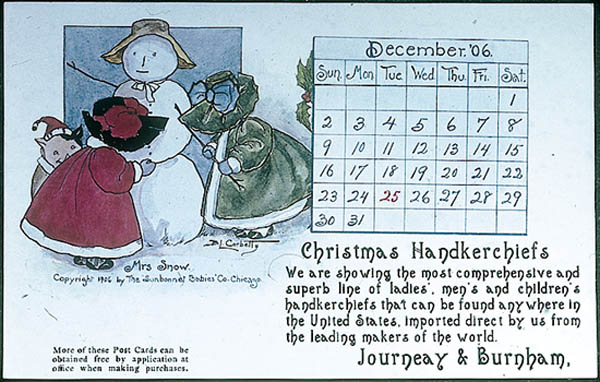Sunbonnet Babies Continue To Charm Collectors
THE SUNBONNET STORY
Denver-born, Bertha Corbett first studied art in Minneapolis beginning in 1884, and then spent a year with Howard Pyle at his famed Drexel Institute of Arts and Sciences. Once launched upon her career, she first made Chicago her home and then returned to Minneapolis. After she married George Melcher in August 1910, the newlyweds moved to Los Angeles where she lived for the rest of her life.
Two stories are told to explain the origin of the Sunbonnet Babies. One: Bertha discovered she couldnt draw faces, so her mother suggested she draw sunbonnets instead. The other (and more likely) places Bertha, already an accomplished artist, in her Minneapolis studio in heated debate with other artists over the importance of a face for showing expression.
Claiming that a face was not necessary to make a figure expressive, she dashed off a drawing of her first Sunbonnet Baby whose face was concealed by a hat. The challenge satisfied, the enthusiasm of her follow artists spurred her to draw other Sunbonnet illustrations and soon she had a career.
Bertha took her Sunbonnet Babies to Minneapolis publisher Byron and Willard and they bought the idea. On June 1 and 2, 1900, a green-covered hardbound book containing the best of her Sunbonnet artwork was presented at a public reception given by Bertha at her studio. Instantly successful, Sunbonnet Babies mania soon swept the nation.
Meanwhile in a distant New Hampshire grammar school, Eulalie Osgood Grover, a teacher, was despondent over the lack of satisfactory primers for young students. By chance, her brother showed her some of Corbetts Sunbonnet drawings and that gave Eulalie an idea.
She wrote to the artist, suggesting they collaborate in producing a primer for school children. Bertha agreed, and soon they had it finished and quickly found a publisher - the prestigious firm of Rand, McNally and Company.
The Sunbonnet Babies Primer, published in 1902, achieved both critical and commercial success. During the next 50 years it became a standard reader in elementary schools everywhere, selling more than one and one-half million copies.
Besides being a primer, the book had songs on the inside cover provided by W.H. Neidinger. Word lists were included at the back of the book. The Sunbonnet Babies Primer was touted as the first textbook to be printed in four colors. the little girls now had white bonnets and red dresses, long their trademark.
The Sunbonnet Babies, mainly May and Molly, also appeared in other readers done by Grover and Corbett. These included The Outdoor Primer and The Sunbonnet Babies in Holland (1915).
To befriend her Sunbonnet girls, Bertha developed a new line of characters - the Overall Boys, who first appeared in a book by that title. In this case, her children had faces. Occasionally the Overall Boys joined the Sunbonnet Girls for an adventure.
In time Bertha Corbett became known as The Mother of the Sunbonnet Babies. Combining text and rhyming verse with illustrations, her books written in conjunction with Eulalie Grover brought her fame and wealth beyond her wildest dreams.
But Bertha was by no means a single-talent artist. She worked in watercolors, did portraits in oils and created beautiful ivory miniatures. But most of her time was spent with her Sunbonnet Babies. At times, she gave chalk talks before large groups. At such presentations, Bertha sketched rapidly as she talked and wove remarkable stories around her children.
So well received were these talks that she seriously considered offers to do a tour on the vaudeville circuit - a profitable venture taken by many cartoonists of the day.
THE SUNBONNET CRAZE
People couldnt get enough of the Sunbonnet Babies. A national craze for the little girls in large Sunbonnets erupted and for a few years they were Americas sweethearts. Businessmen flocked to Corbetts door seeking rights to use the characters in products and for advertising. Within a couple of years of their first appearance, copycat artists, especially illustrators doing souvenir postcards, sprung up in great numbers. Notable among these were Dorothy Dixon and Bernhardt Wall.
In the early 1900s Americans bathed using Sunbonnet Babies towels and washcloths, ate from Sunbonnet dishware and warmed themselves with quilts appliquéd with Sunbonnet die-cuts. They sent Sunbonnet greeting cards on all holidays and bought souvenirs and keepsakes decorated with their likenesses.
Todays collectors can select from a large array of Sunbonnet items originally designed for childrens use. The list includes tea and china sets, prints, dolls, paint boxes and dry goods for the nursery, bedroom or bath. Also, Royal Bayreuth China Company of Germany marketed childrens dishes from 1902 to 1920, then reintroduced the Sunbonnet these a half-century later by selling plates and porcelain bells decorated with the characters.
Other collectibles of great appeal include candlesticks, candy dishes, hatpin holders, tankard creamers and souvenir plates. On sale at the 1901 Pan-American Exposition, held in Buffalo, New York, were several different five-inch by six-inch hand-cut and hand-colored die-cuts of the Sunbonnet Babies in various activities. They are seen pushing a baby in a carriage, lighting a firecracker, etc. Pan American Souvenir is printed in script and on each is a 1900 copyright notice by Bertha Corbett.
Postcards of Bertha Corbetts darlings appeared as early as 1904. In all there were 15 sets of Sunbonnet Babies postcards, totaling about 100 to 120 cards, which were marketed as keepsake souvenirs, as well as countless singles sold from store racks as all-purpose greetings. The publics fascination with Sunbonnet postcards lasted about a decade.
The first two, published in 1904 by J.I. Austin Co. of Chicago, had the artwork of Corbett and carried her signature. One is a Days of the Week series of six; the other a group of six miscellaneous topics, such as In the Good Old Summertime.
Also, the Sunbonnet Babies Co., Chicago, marketed an advertising calendar months set duplicating in style and intent similar seta by Outcault Co. which featured Buster Brown and the yellow kid.












